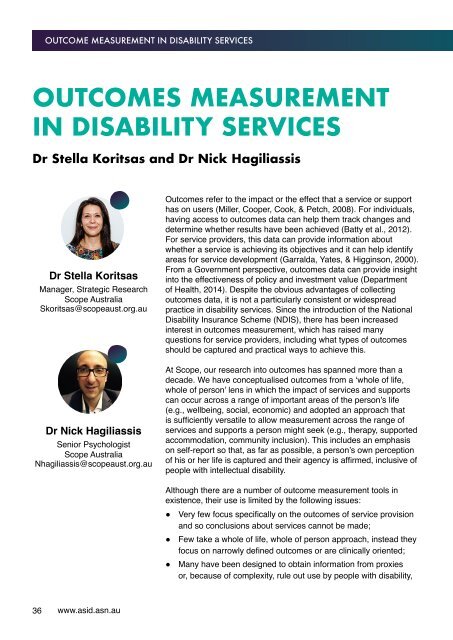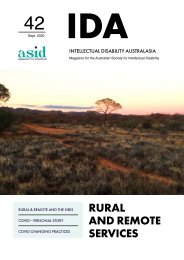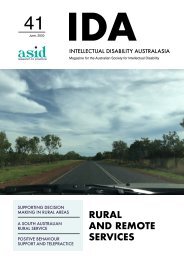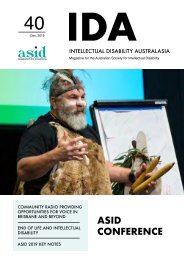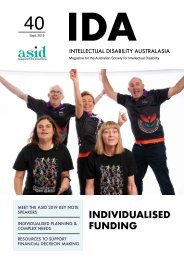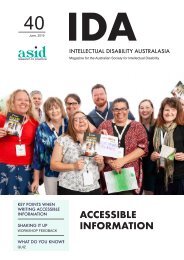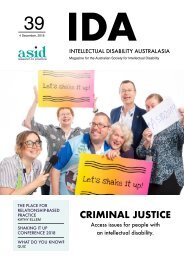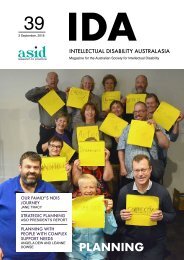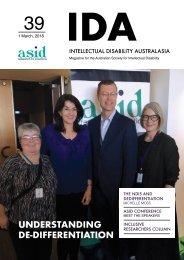Create successful ePaper yourself
Turn your PDF publications into a flip-book with our unique Google optimized e-Paper software.
OUTCOME MEASUREMENT IN DISABILITY SERVICES<br />
OUTCOMES MEASUREMENT<br />
IN DISABILITY SERVICES<br />
Dr Stella Koritsas and Dr Nick Hagiliassis<br />
Dr Stella Koritsas<br />
Manager, Strategic Research<br />
Scope Australia<br />
Skoritsas@scopeaust.org.au<br />
Dr Nick Hagiliassis<br />
Senior Psychologist<br />
Scope Australia<br />
Nhagiliassis@scopeaust.org.au<br />
Outcomes refer to the impact or the effect that a service or support<br />
has on users (Miller, Cooper, Cook, & Petch, 2008). For individuals,<br />
having access to outcomes data can help them track changes and<br />
determine whether results have been achieved (Batty et al., 2012).<br />
For service providers, this data can provide information about<br />
whether a service is achieving its objectives and it can help identify<br />
areas for service development (Garralda, Yates, & Higginson, 2000).<br />
From a Government perspective, outcomes data can provide insight<br />
into the effectiveness of policy and investment value (Department<br />
of Health, 2014). Despite the obvious advantages of collecting<br />
outcomes data, it is not a particularly consistent or widespread<br />
practice in disability services. Since the introduction of the National<br />
Disability Insurance Scheme (NDIS), there has been increased<br />
interest in outcomes measurement, which has raised many<br />
questions for service providers, including what types of outcomes<br />
should be captured and practical ways to achieve this.<br />
At Scope, our research into outcomes has spanned more than a<br />
decade. We have conceptualised outcomes from a ‘whole of life,<br />
whole of person’ lens in which the impact of services and supports<br />
can occur across a range of important areas of the person’s life<br />
(e.g., wellbeing, social, economic) and adopted an approach that<br />
is sufficiently versatile to allow measurement across the range of<br />
services and supports a person might seek (e.g., therapy, supported<br />
accommodation, community inclusion). This includes an emphasis<br />
on self-report so that, as far as possible, a person’s own perception<br />
of his or her life is captured and their agency is affirmed, inclusive of<br />
people with intellectual disability.<br />
Although there are a number of outcome measurement tools in<br />
existence, their use is limited by the following issues:<br />
●●<br />
●●<br />
●●<br />
Very few focus specifically on the outcomes of service provision<br />
and so conclusions about services cannot be made;<br />
Few take a whole of life, whole of person approach, instead they<br />
focus on narrowly defined outcomes or are clinically oriented;<br />
Many have been designed to obtain information from proxies<br />
or, because of complexity, rule out use by people with disability,<br />
36 www.asid.asn.au


